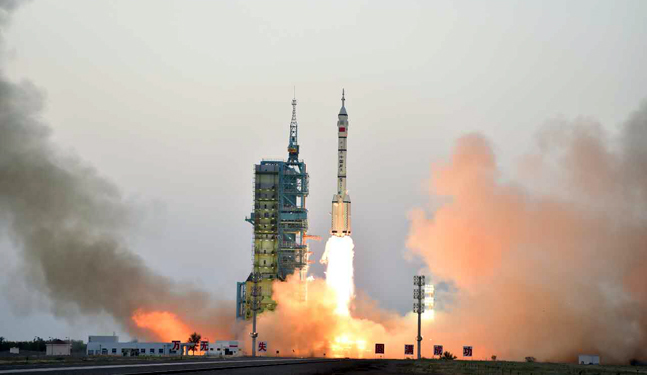China's reusable experimental spacecraft returns to Earth after two-day mystery mission
The craft apparently deployed something during its brief orbital trip.

China's mysterious reusable experimental spacecraft has safely landed after two days in space, according to state media, and may have deployed a satellite while in orbit.
A brief report in the state-run Chinese media outlet Xinhua said the spacecraft, which launched on Friday (Sept. 4), landed on Sunday (Sept. 6). The launch has been linked with China's plans these past few years to build and operate a reusable space plane, although that connection has not yet been confirmed.
The spacecraft touched down at "the scheduled landing site after a two-day in-orbit operation," Xinhua added, without specifying the landing site's location. The mission launched on a Long March-2F rocket from the Jiuquan Satellite Launch Center in northwest China, at a time that Chinese officials have not yet specified.
Related: Latest news about China's space program
The landing site is thought to be in the Taklamakan Desert, which is also in northwest China, according to a report from Forbes that cited astrophysicist and satellite tracker Jonathan McDowell's projections on Twitter, based on the object's orbit.
McDowell, an astronomer at the Center for Astrophysics | Harvard & Smithsonian (CfA), stressed that we cannot assume the spacecraft is a space plane. "'Reusable' doesn't necessarily mean 'winged,'" he wrote on Twitter on Sunday. "Still could be a [SpaceX] Dragon-style capsule, with a parachute, landing in the Taklamakan somewhere. Exact launch and landing times not announced by China."
China has announced the name of the spacecraft, which is called Chongfu Shiyong Shiyan Hangtian Qi, McDowell said on Twitter on Friday. The name "translates as Repeat Use Test Space Craft (let's say Reusable Test Spacecraft a bit more loosely)," McDowell added.
Get the Space.com Newsletter
Breaking space news, the latest updates on rocket launches, skywatching events and more!
Also, analysis of a newly found object in space suggests that the Chinese spacecraft released something while it was in orbit, according to SpaceNews, although what that may be is pure speculation.
"My analysis suggests it was ejected from China's experimental spacecraft near 22:25 UT [6:25 p.m. EDT] on the 5th, about two revolutions before landing," Marco Langbroek, a Leiden University space situational awareness consultant, wrote on Twitter on Sunday. He credited McDowell with spotting the object in the first place.
SpaceNews said that, whatever the object was, it was released two orbits before the spacecraft began its return to Earth. Neither Chinese nor United States space-tracking organizations have released details, the report added.
"Chinese crew capsules have previously released 'Banxing' small companion satellites for monitoring," SpaceNews said. "An experimental new-generation crew spacecraft released a test inflatable reentry and descent technology module in May. The experiment suffered an anomaly during reentry."
To be fair, the Chinese aren't alone in keeping the activities of experimental spacecraft close to the vest. China's discussions of sending a space plane aloft have been compared with the secretive X-37B that the United States Space Force flies in orbit for months at a time, with little information about its activities.
That said, space observers have pointed out that the extra precautions associated with the recent Chinese launch, such as not releasing images of the spacecraft or letting observers nearby, sound strange given China's assurance that the intention of the mission is peaceful.
"The successful flight marked the country's important breakthrough in reusable spacecraft research, and is expected to offer convenient and low-cost round trip transport for the peaceful use of the space," Xinhua said in its report on Sunday.
Follow Elizabeth Howell on Twitter @howellspace. Follow us on Twitter @Spacedotcom and on Facebook.
Join our Space Forums to keep talking space on the latest missions, night sky and more! And if you have a news tip, correction or comment, let us know at: community@space.com.

Elizabeth Howell (she/her), Ph.D., was a staff writer in the spaceflight channel between 2022 and 2024 specializing in Canadian space news. She was contributing writer for Space.com for 10 years from 2012 to 2024. Elizabeth's reporting includes multiple exclusives with the White House, leading world coverage about a lost-and-found space tomato on the International Space Station, witnessing five human spaceflight launches on two continents, flying parabolic, working inside a spacesuit, and participating in a simulated Mars mission. Her latest book, "Why Am I Taller?" (ECW Press, 2022) is co-written with astronaut Dave Williams.









